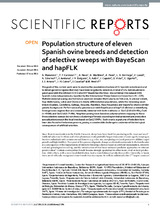Mostrar el registro sencillo del ítem
Population structure of eleven Spanish ovine breeds and detection of selective sweeps with BayeScan and hapFLK
| dc.contributor.author | Manunza, A. | |
| dc.contributor.author | Cardoso, T.F. | |
| dc.contributor.author | Noce, A. | |
| dc.contributor.author | Martínez-Moreno, Álvaro | |
| dc.contributor.author | Pons, A. | |
| dc.contributor.author | Bermejo, L.A. | |
| dc.contributor.author | Landi, Vincenzo | |
| dc.contributor.author | Sànchez, A. | |
| dc.contributor.author | Jordana, J. | |
| dc.contributor.author | Delgado-Bermejo, J.V. | |
| dc.contributor.author | Adán, S. | |
| dc.contributor.author | Capote, J.F. | |
| dc.contributor.author | Vidal, O. | |
| dc.contributor.author | Ugarte, E. | |
| dc.contributor.author | Arranz, J.J. | |
| dc.contributor.author | Calvo, J.H. | |
| dc.contributor.author | Casellas, J. | |
| dc.contributor.author | Amills, M. | |
| dc.date.accessioned | 2018-10-16T11:50:48Z | |
| dc.date.available | 2018-10-16T11:50:48Z | |
| dc.date.issued | 2016 | |
| dc.identifier.uri | http://hdl.handle.net/10396/17295 | |
| dc.description.abstract | The goals of the current work were to analyse the population structure of 11 Spanish ovine breeds and to detect genomic regions that may have been targeted by selection. A total of 141 individuals were genotyped with the Infinium 50 K Ovine SNP BeadChip (Illumina). We combined this dataset with Spanish ovine data previously reported by the International Sheep Genomics Consortium (N = 229). Multidimensional scaling and Admixture analyses revealed that Canaria de Pelo and, to a lesser extent, Roja Mallorquina, Latxa and Churra are clearly differentiated populations, while the remaining seven breeds (Ojalada, Castellana, Gallega, Xisqueta, Ripollesa, Rasa Aragonesa and Segureña) share a similar genetic background. Performance of a genome scan with BayeScan and hapFLK allowed us identifying three genomic regions that are consistently detected with both methods i.e. Oar3 (150–154 Mb), Oar6 (4–49 Mb) and Oar13 (68–74 Mb). Neighbor-joining trees based on polymorphisms mapping to these three selective sweeps did not show a clustering of breeds according to their predominant productive specialization (except the local tree based on Oar13 SNPs). Such cryptic signatures of selection have been also found in the bovine genome, posing a considerable challenge to understand the biological consequences of artificial selection | es_ES |
| dc.format.mimetype | application/pdf | es_ES |
| dc.language.iso | eng | es_ES |
| dc.publisher | Nature.com | es_ES |
| dc.rights | https://creativecommons.org/licenses/by-nc-nd/4.0/ | es_ES |
| dc.source | Scientific Reports 6:27296 (2016) | es_ES |
| dc.subject | Spanish ovine breed | es_ES |
| dc.subject | Population structure | es_ES |
| dc.subject | Genomic regions | es_ES |
| dc.title | Population structure of eleven Spanish ovine breeds and detection of selective sweeps with BayeScan and hapFLK | es_ES |
| dc.type | info:eu-repo/semantics/article | es_ES |
| dc.relation.publisherversion | http://dx.doi.org/10.1038/srep27296 | es_ES |
| dc.relation.projectID | Gobierno de España. RZ2011-00015-C03-01 | es_ES |
| dc.relation.projectID | Gobierno de España. SEV-2015-0533 | es_ES |
| dc.rights.accessRights | info:eu-repo/semantics/openAccess | es_ES |

